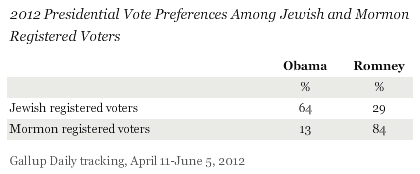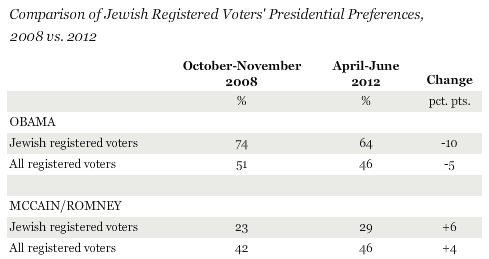PRINCETON, NJ -- Mormon registered voters overwhelmingly support the candidacy of the first major-party presidential candidate of the Mormon faith, with 84% saying they would vote for Mitt Romney, compared with 13% who prefer Barack Obama. Obama, meanwhile, enjoys solid support from Jewish voters, 64% to 29%.

Gallup previously analyzed the preferences of the major religious groups in the United States. Currently, Protestants favor Romney by 52% to 40%, nonreligious voters favor Obama by 65% to 25%, and Catholics are evenly divided between the two (46% Obama, 45% Romney).
Roughly 2% of Americans identify their religious faith as Mormon, or the Church of Jesus Christ of Latter-day Saints. Two percent also identify their religion as Jewish. Though relatively small in number, Jews and Mormons represent the next-largest religious faiths in the United States after Protestants (including those who identify simply as Christian) and Catholics.
Since Gallup began tracking 2012 presidential vote preferences in April, it has interviewed more than 500 Jewish and Mormon registered voters each. Overall, U.S. registered voters are evenly divided in their voting preferences, with 46% supporting Romney and 46% Obama.
U.S. Jews and Mormons have been strongly politically aligned with the Democratic and Republican parties, respectively, so their current candidate preferences are consistent with their usual political leanings. Gallup Daily tracking from January 2011-May 2012 shows 70% of Mormons identifying as Republicans or leaning to the Republican Party, and 19% identifying as or leaning Democratic. Meanwhile, 64% of Jews affiliate with the Democratic Party and 27% with the Republican Party.
Although Romney's current advantage among Mormons is greater than Obama's is among Jews, Jews may be more likely to turn out and vote than Mormons are. According to Gallup Daily tracking since mid-April, 83% of Jewish registered voters say they definitely will vote, compared with 77% of Mormon registered voters. The national average among all registered voters is 78%.
Romney Doing Better Among Mormons, Obama Worse Among Jews, Than in 2008
In comparison to registered-voter data from October and November 2008, Romney appears to be doing better among Mormons than John McCain did, and Obama appears to be doing worse among Jews than he did in the last election. This is the case on both an absolute and a relative basis, taking into account the fact that Obama is running less well now among all registered voters than he did in the fall of 2008.
Among all registered voters in October-November 2008, Obama led McCain, 51% to 42%, compared with a 46% to 46% tie with Romney this year. So overall, Obama is running about five percentage points lower than he did just before the 2008 election among registered voters, and Romney is running four points better than McCain did.
In 2008, Mormons preferred McCain to Obama by 75% to 19%. Romney's current 84% share of the Mormon vote is thus nine points better than McCain's, and five points better than the average shift from McCain to Romney among all registered voters.

Among Jews, Obama's current 64% to 29% advantage compares with a 74% to 23% advantage before the election in 2008. Thus, he is running 10 points lower among Jewish registered voters than in 2008, which is five points worse than his decline among all registered voters compared with 2008.

Implications
Jewish and Mormon voters show decided preferences for Obama and Romney, respectively, consistent with their usual political leanings. Romney's historic candidacy as the first Mormon presidential candidate has him currently running a bit more strongly among that religious group than McCain did as the Republican candidate in 2008, and above what would be expected, given the overall increase in support for the GOP presidential candidate compared with 2008.
Obama remains the favorite of Jewish voters but appears to be running a bit weaker among them than he did in 2008, given the 10-point drop in Jewish support for him compared with a five-point drop among all voters.
Given the relatively small size of each group, and their strong Democratic and Republican leanings, Jewish and Mormon voters typically are not critical groups in deciding presidential election outcomes. However, with Romney and Obama so closely matched thus far, every additional bit of support they can muster among these groups could be valuable to their winning the election.
Track every angle of the presidential race on Gallup.com's Election 2012 page.
Survey Methods
Results are based on telephone interviews conducted as part of Gallup Daily tracking April 11-June 5, 2012, with a random sample of 24,181 registered voters, aged 18 and older, living in all 50 U.S. states and the District of Columbia.
For results based on the total sample of registered voters, one can say with 95% confidence that the maximum margin of sampling error is ±1 percentage point.
For results based on the total sample of 576 Jewish registered voters, one can say with 95% confidence that the maximum margin of sampling error is ±5 percentage points.
For results based on the total sample of 524 Mormon registered voters, one can say with 95% confidence that the maximum margin of sampling error is ±5 percentage points.
Interviews are conducted with respondents on landline telephones and cellular phones, with interviews conducted in Spanish for respondents who are primarily Spanish-speaking. Each sample includes a minimum quota of 400 cell phone respondents and 600 landline respondents per 1,000 national adults, with additional minimum quotas among landline respondents by region. Landline telephone numbers are chosen at random among listed telephone numbers. Cell phone numbers are selected using random-digit-dial methods. Landline respondents are chosen at random within each household on the basis of which member had the most recent birthday.
Samples are weighted by gender, age, race, Hispanic ethnicity, education, region, adults in the household, and phone status (cell phone only/landline only/both, cell phone mostly, and having an unlisted landline number). Demographic weighting targets are based on the March 2011 Current Population Survey figures for the aged 18 and older non-institutionalized population living in U.S. telephone households. All reported margins of sampling error include the computed design effects for weighting and sample design.
In addition to sampling error, question wording and practical difficulties in conducting surveys can introduce error or bias into the findings of public opinion polls.
For more details on Gallup's polling methodology, visit www.gallup.com.
